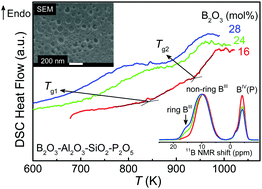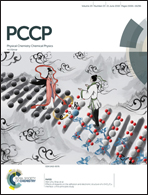Nano-phase separation and structural ordering in silica-rich mixed network former glasses†
Abstract
We investigate the structure, phase separation, glass transition, and crystallization in a mixed network former glass series, i.e., B2O3–Al2O3–SiO2–P2O5 glasses with varying SiO2/B2O3 molar ratio. All the studied glasses exhibit two separate glassy phases: droplet phase (G1) with the size of 50–100 nm and matrix phase (G2), corresponding to a lower calorimetric glass transition temperature (Tg1) and a higher one (Tg2), respectively. Both Tg values decrease linearly with the substitution of B2O3 for SiO2, but the magnitude of the decrease is larger for Tg1. Based on nuclear magnetic resonance and Raman spectroscopy results, we infer that the G1 phase is rich in boroxol rings, while the G2 phase mainly involves the B–O–Si network. Both phases contain BPO4- and AlPO4-like units. Ordered domains occur in G2 upon isothermal and dynamic heating, driven by the structural heterogeneity in the as-prepared glasses. The structural ordering lowers the activation energy of crystal growth, thus promoting partial crystallization of G2. These findings are useful for understanding glass formation and phase separation in mixed network former oxide systems, and for tailoring their properties.

- This article is part of the themed collection: 2018 PCCP HOT Articles


 Please wait while we load your content...
Please wait while we load your content...